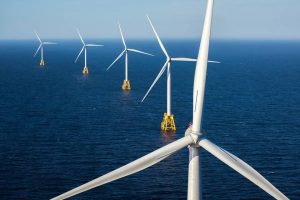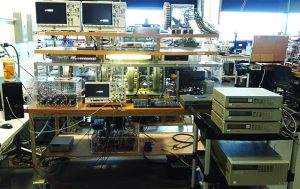“Megawatt-Scale Power-Electronic-Integrated Generator with Controlled DC Output,” ARPA-E $2 Million Grant Awarded to Professors Arijit Banerjee, Alejandro Domínguez-García, George Gross and Kiruba Haran
 High efficiency, power density, and reliability are critical in megawatt-class wind energy conversion systems. Operating over a limited speed range, the generator ac output is usually rectified first to dc, enabling subsequent connection to an electric grid. Conventional high-power ac-to-dc conversion architectures predominantly rely on using fully controlled power-electronic switches, making the system bulky, lossy, and less reliable. Our objective is to create the world’s most efficient, reliable, and compact wind energy conversion system through an alternative approach: integrating a multi-port permanent-magnet synchronous generator (PMSG) with series-stacked power converters made of active and passive rectifiers. The active rectifier, made of fully controlled power-electronic switches such as IGBTs or SiC MOSFETs, regulates the dc bus voltage while passive rectifiers, made of diodes,
High efficiency, power density, and reliability are critical in megawatt-class wind energy conversion systems. Operating over a limited speed range, the generator ac output is usually rectified first to dc, enabling subsequent connection to an electric grid. Conventional high-power ac-to-dc conversion architectures predominantly rely on using fully controlled power-electronic switches, making the system bulky, lossy, and less reliable. Our objective is to create the world’s most efficient, reliable, and compact wind energy conversion system through an alternative approach: integrating a multi-port permanent-magnet synchronous generator (PMSG) with series-stacked power converters made of active and passive rectifiers. The active rectifier, made of fully controlled power-electronic switches such as IGBTs or SiC MOSFETs, regulates the dc bus voltage while passive rectifiers, made of diodes,  processes bulk of the power. The passive rectifiers operate with a high input power factor by eliminating the filter capacitors at the dc output. Theoretical analysis shows that the active rectifier processes only a maximum of 25% of the rated power while the PMSG operates in a speed range similar to the conventional doubly-fed induction generator—the workhorse of modern wind power industry.
processes bulk of the power. The passive rectifiers operate with a high input power factor by eliminating the filter capacitors at the dc output. Theoretical analysis shows that the active rectifier processes only a maximum of 25% of the rated power while the PMSG operates in a speed range similar to the conventional doubly-fed induction generator—the workhorse of modern wind power industry.
This grant builds on research funded by the CEME to support Professor Banerjee’s student Phuc Huynh’s work studying efficient off-shore wind generators. It is supporting him and the work of four additional CEME students. (Description from ARPA-E abstract.)
Comments - No Responses to ““Megawatt-Scale Power-Electronic-Integrated Generator with Controlled DC Output,” ARPA-E $2 Million Grant Awarded to Professors Arijit Banerjee, Alejandro Domínguez-García, George Gross and Kiruba Haran”
Sorry but comments are closed at this time.